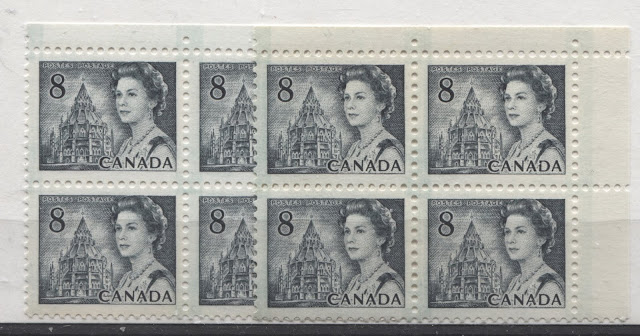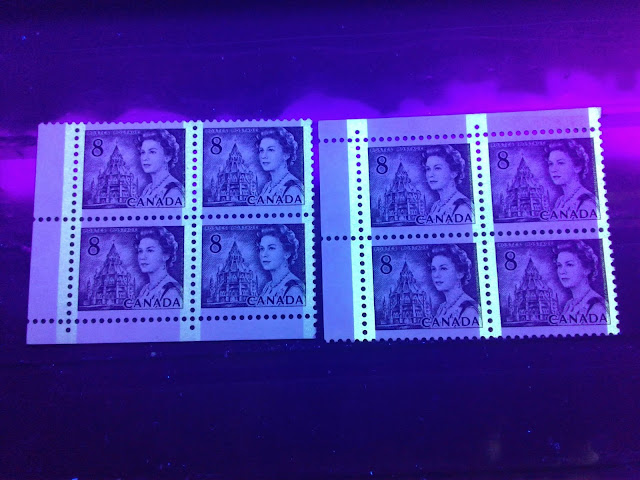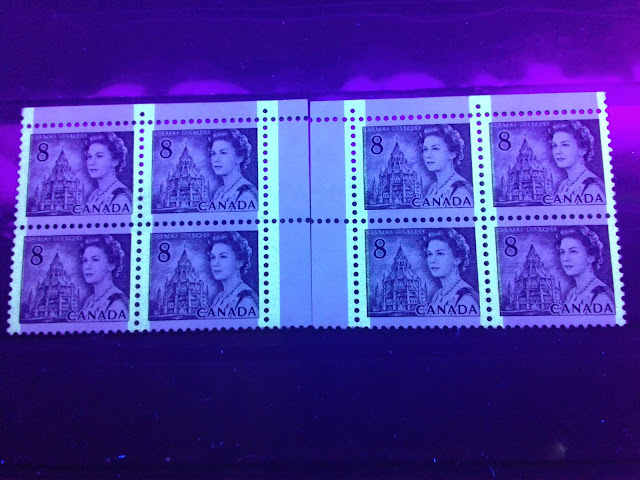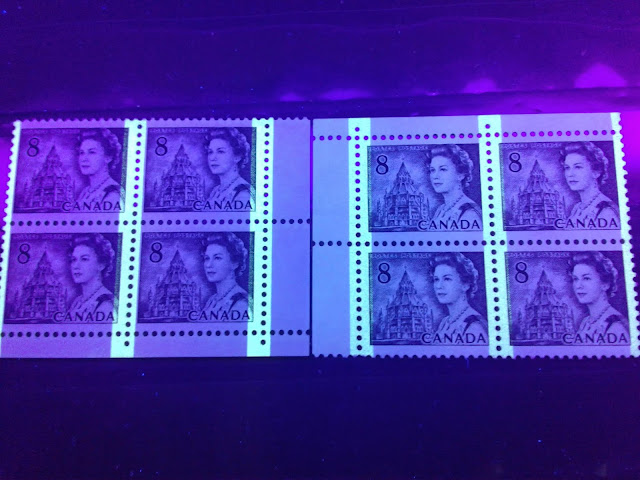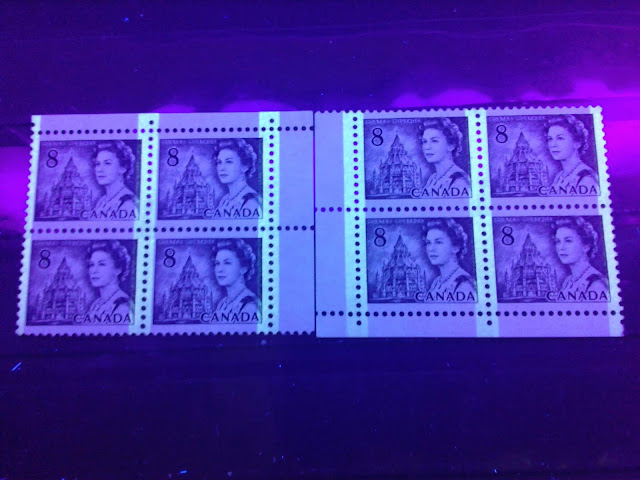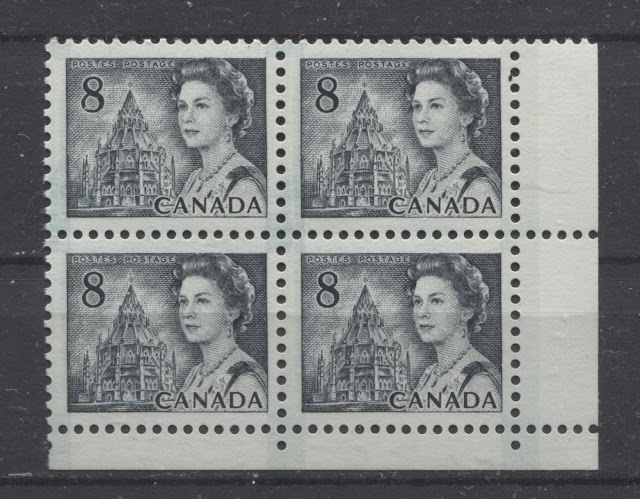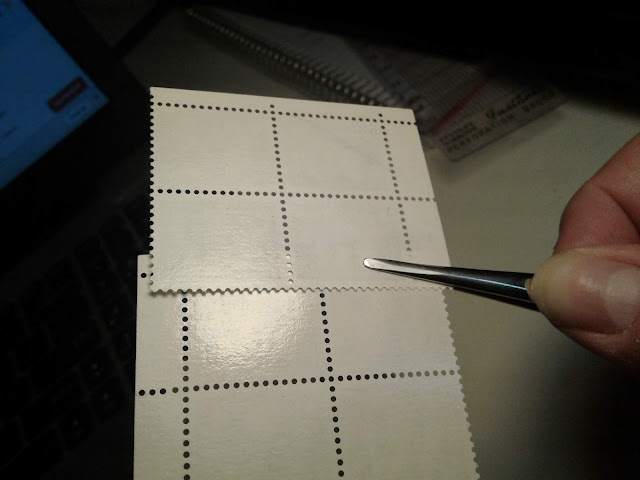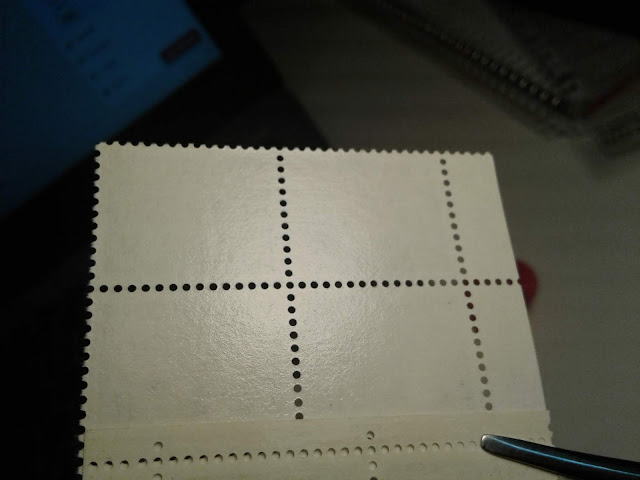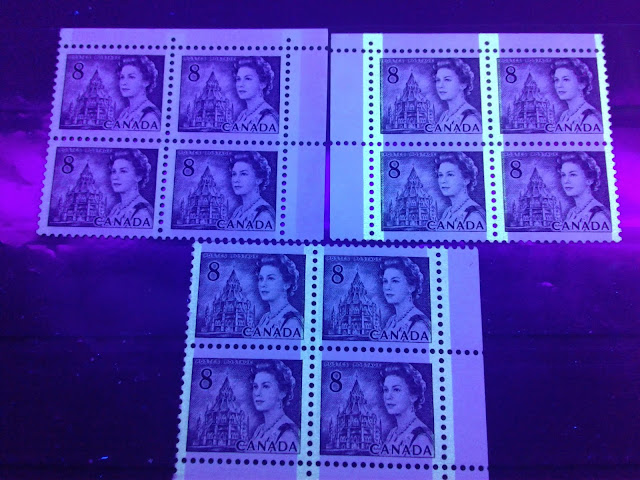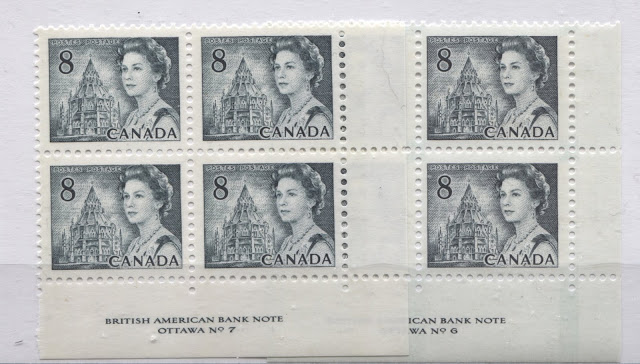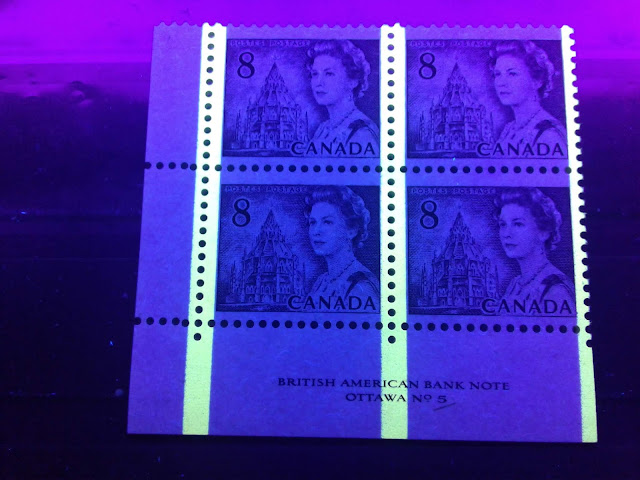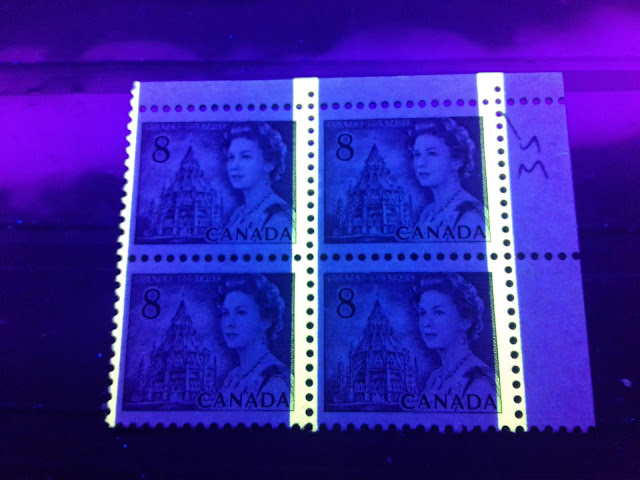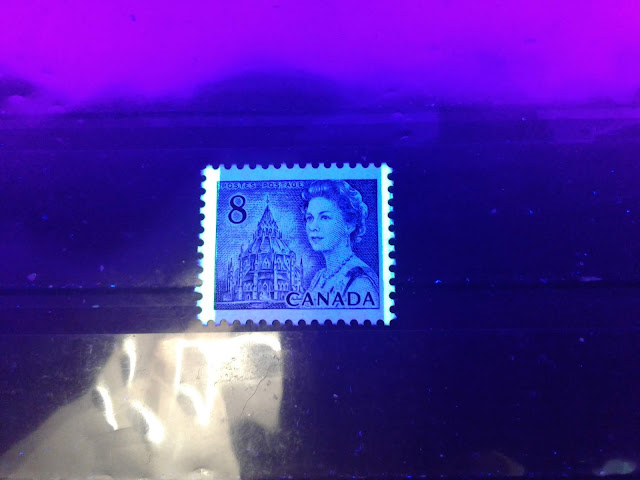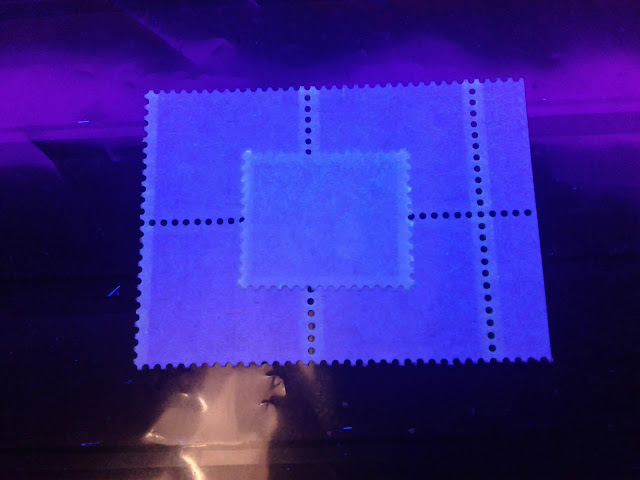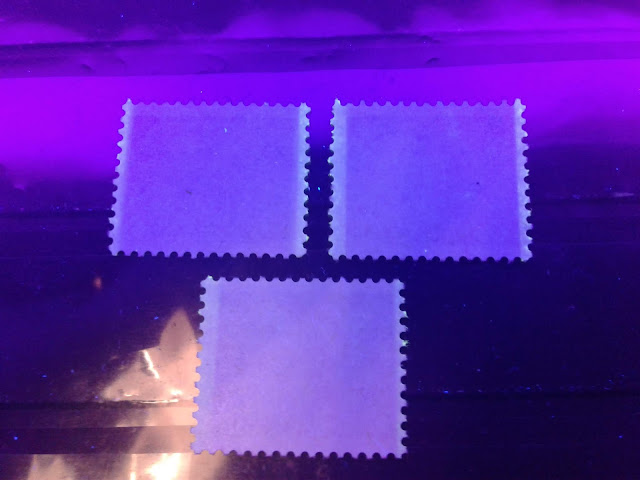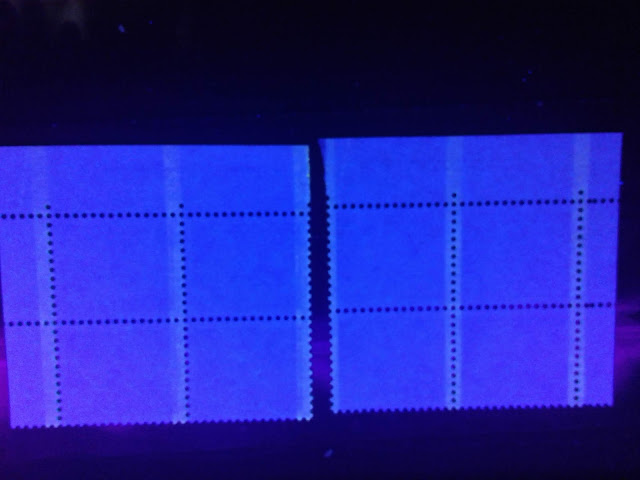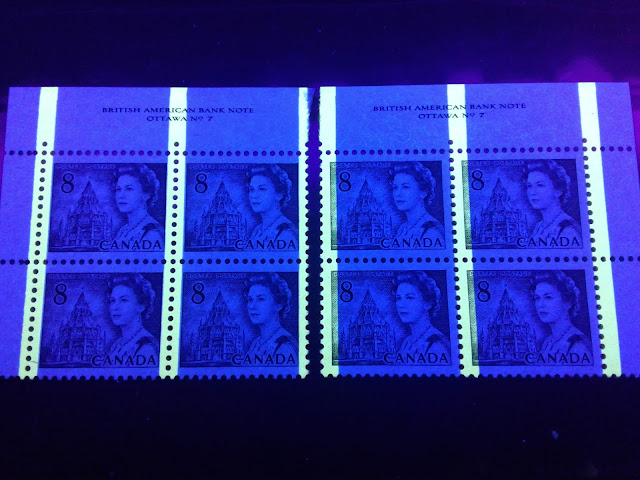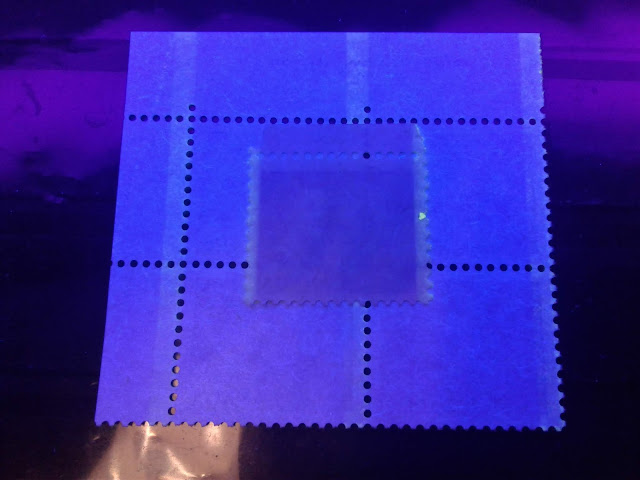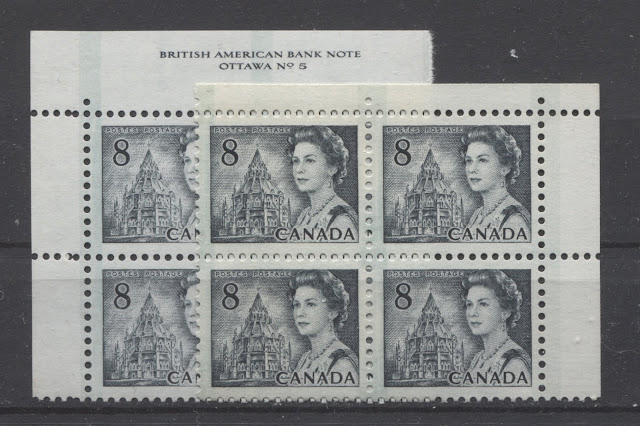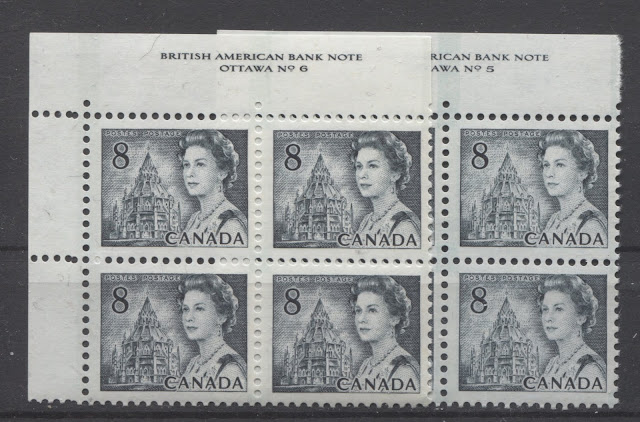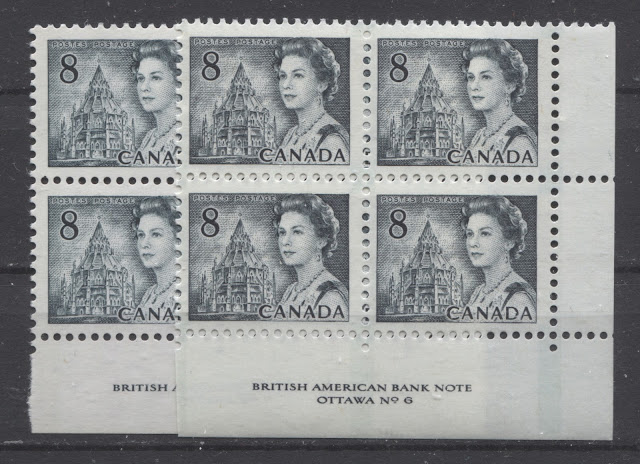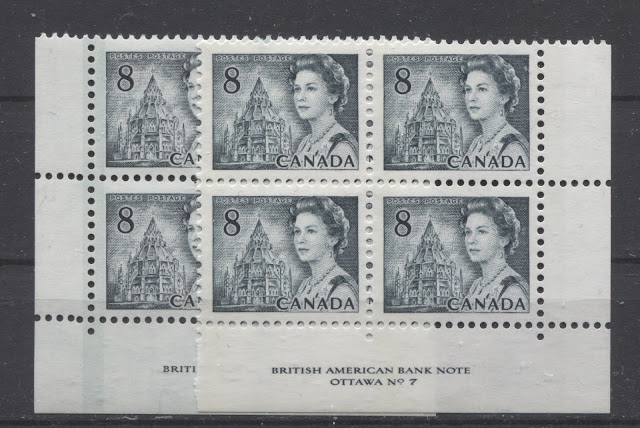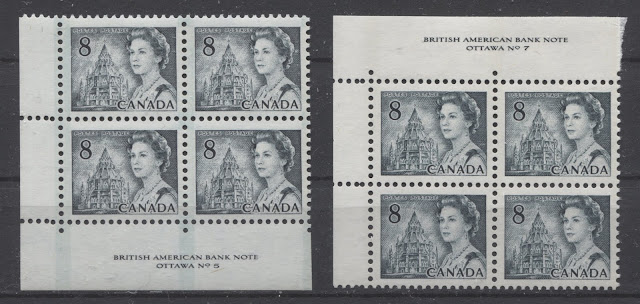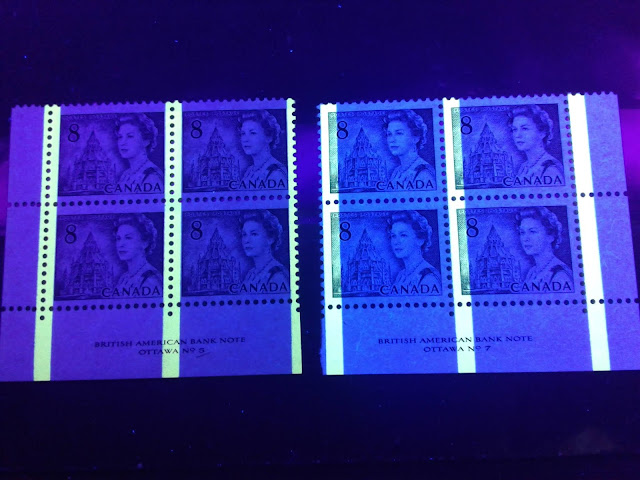Today is the third of four posts dealing with the last of the low values of this issue: the 8c Parliamentary Library stamp. In this week's post, I will be looking at the printings of the sheet stamps that were Ottawa tagged. According to Unitrade, the sheet stamps were first issued at the same time as the Winnipeg tagged stamps, on December 30, 1971, using the then unstable OP-4 tagging compound. This compound migrated both through the stamps and onto any porous material they came into contact with. The result was that the tagging bars faded to the point that they were useless to the mail sorting machines, so that by late 1972, the taggant compound was replaced by a more stable OP-2 compound. The new printings with the more stable OP-2 tagging were issued in 1973 between April and July, well into the period covered by the new Caricature issue that replaced this one, but before the release of the low values of that set.
The CBN coil stamps with OP-2 tagging were issued at the same time as the untagged stamps, on December 30, 1971.
Unitrade lists two varieties of the OP-4 tagging, one with dextrose gum and the other with PVA and lists three varieties of the OP-2 tagging, all with PVA gum. There is also a scratch on the forehead variety listed for the OP-2 tagged stamps. Interestingly, there is no listing for the extra spire variety on these stamps, even though they likely should exist with OP-4 tagging. No fewer than five varieties are now listed for the coil stamps, in addition to two varieties of imperforate pairs. This is far more coverage than was afforded these stamps even a few years ago. So, more and more discoveries are being made for this set all the time.
The remainder of this post will now go over the printings of the sheet stamps in more detail. I will deal with the coil stamps in next week's post, which will also discuss the booklet stamps.
The OP-4 Tagged Sheet Stamps - Unitrade #544pi and 544pxix
Paper Characteristics Other Than Fluorescence
I have found three types of paper used to print these stamps, ignoring the fluorescent properties:
The whiter paper is shown by the block on the left, while the cream paper is shown by the block on the right.
Paper Fluorescence
Unitrade lists this stamp as existing either on non-fluorescent paper for those printings with dextrose gum, and on high fluorescent flecked paper for those printings with PVA gum. I do not have any examples of the PVA gum printing to work with in preparing this post, so unfortunately I cannot comment on the paper fluorescence of those printings. However, I have found no fewer than 6 subtle varieties of dull fluorescent paper, one of which is very close to being truly non-fluorescent. Unitrade calls this non-fluorescent, but in reality it is really different variations of dull fluorescent and dull fluorescent flecked paper. The scans below show the different types:
The block on the right is the dull fluorescent greyish paper, containing no fluorescent fibres. The paper of the block on the left is dull fluorescent greyish white with no fluorescent fibres.
The block on the left is dull fluorescent bluish white, with no fluorescent fibres, while the block on the right is dull fluorescent greyish, also with no visible fluorescent fibres in the paper.
The block on the left is non-fluorescent greyish under the UV light, with very few low fluorescent fibres visible in the paper. The block on the right is dull fluorescent ivory grey, also containing very few low fluorescent fibres.
The block on the left is the dull fluorescent greyish white paper containing very few low fluorescent fibres. The block on the right is the same non-fluorescent greyish paper that was shown in the previous picture.
Shades
I have only found one shade of ink on these stamps, though all of the stamps and blocks that I have in my possession are the dextrose gum varieties. The shade is a deep bluish slate that has a fairly good balance of blue and slate. The shade is shown in the scan of the block shown below:
Gum
The dextrose gum found on these printings exists in three of the four types that I have previously discussed: high gloss, semi gloss and semi-smooth. I have not yet seen an example of the crackly gum on these stamps. The pictures below show all three types of gum:
The high gloss gum is shown in the bottom block in the picture above, while the semi-gloss gum is shown in the top block.
The picture above shows the semi-smooth gum.
I haven't seen the PVA gum on the one printing that is listed by Unitrade to exist with PVA gum, being the high fluorescent flecked paper. However, as I will note in the next section dealing with the OP-2 tagging, all of the PVA gum that I have seen on these stamps has the same appearance: a cream coloured, smooth PVA gum with a satin sheen.
Perforation
The perforation on these stamps remains at comb 12.5 x 12, following the exact same configuration as the earlier printings, in which the side margins of the sheets are fully perforated through, but only a single extension hole appears in the top and bottom sheet margins. I have not found any variation in the gauge, or configuration of the perforation.
Tagging
The OP-4 tagging was applied in 4 mm wide bands that ran down the vertical perforations of each column in the sheets. The spacing between the tagging bars is 20 mm in the horizontal direction. In all cases that I have examined the taggant has become coloured by the printing ink, so that the tagging bars appear a very light azure colour in normal light, as shown by the following scan:
The block at upper left is an example of tagging that has almost completely faded. The upper right shows an example of 4 mm OP-4 tagging that is full strength. The block at the bottom shows tagging that has undergone slight fading. Generally, the brighter the tagging the closer to yellow the colour is and the further from green it is.
Plate Flaws
Curiously, there are no listed plate flaws on this stamp even though it is more than likely that the PVA gum printings were from plate 4, and it is on plate 4 that we see the extra spire variety. Of course, many of these stamps can be found with the over 75 constant cylinder varieties that can be found on these stamps.
Bringing it All Together
All of these stamps were trimmed before distribution to the post offices, so there are no plate blocks to collect - only blank corners, of which there are up to 12 different collectible positions, depending on the width of the selvage tabs. I have noted three different types of paper, each of which could exist in at least six different grades of fluorescence, and each of which can exist with three different types of dextrose gum. Assuming that only one variety of the PVA gum printing can exist, there could be up to 3 x 6 x 3 = 54 different varieties of the dextrose gum stamps, and up to 54 x 12 = 648 collectible corner blocks.
The OP-2 Tagged Sheet Stamps - Unitrade #544piv, 544pv, 544pvii and 544pviii
Paper Characteristics Other Than Fluorescence
Unitrade lists this stamp as existing on smooth paper and vertically ribbed paper. The smooth papers are listed for both listed varieties of fluorescence, while the ribbed paper is only listed as existing on the high fluorescent paper.
The ribbed paper found on these printings is very strongly ribbed on the face, with the vertical ridges being very obvious to the naked eye. The paper is horizontal wove and is very lightly coated on the printing surface, as can be seen under magnification. The paper is a light cream colour when viewed against a stark white background. When held up and viewed against strong back lighting, the vertical mesh pattern is highly visible in the paper.
The paper of the plate 5 and 6 printings has a smooth appearance, with no ribbing visible, is lightly coated on the printing surface, has a slightly bluish appearance from the printing ink used to print the stamps and shows a clear horizontal mesh pattern when viewed against strong back lighting. The paper from plate 7 is much the same, except for the colour: plate 7 paper is a definite light cream colour, whereas plate 6 and plate 5 paper is white with a bluish undertone.
The scan below shows the difference in appearance between the cream paper of plate 7, versus the bluish-greyish white paper of plates 5 and 6, when viewed against a bright white background:
Paper Fluorescence
Unitrade now lists two levels of fluorescence for these printings:
This is the cream high fluorescent paper.
This is the whiter high fluorescent paper, shown against a block of the regular plate 7 high fluorescent paper.
Shades
On these stamps each plate seems to have resulted in stamps that are a distinctly different shade of slate. The shades seem to be uniform within each of plates 5, 6 and 7, and this uniformity may well be an aid to identifying singles and blank blocks by plate. The plate 5 printings seem to be a pale greyish slate shade that contains much less blue to the point that it appears more greyish than bluish. The scan below shows a side-by side comparison of this shade next to the deep bluish slate of the OP-4 printing:
As you can see, the difference is quite marked. The pale greyish slate is shown on the left, while the deep bluish slate is shown on the right.
The stamps from plate 6 are a deeper version of the greyish slate shade, which clearly contains more black and grey and less blue. It is shown next to a plate 5 block to illustrate the difference in the shades:
The deep slate is shown on the left, while the pale greyish slate is shown on the right. In this scan, the pale greyish slate appears quite bluish as well.
The printings from plate 7 are a clear slate greenish blue, which contains more blue and green than it does black. It is a very distinct shade, as the following comparison scan shows:
Gum
The gum found on all of these stamps is a smooth, white PVA gum with a satin sheen.
Perforation
The perforation on these stamps remains at comb 12.5 x 12, following the exact same configuration as the earlier printings, in which the side margins of the sheets are fully perforated through, but only a single extension hole appears in the top and bottom sheet margins. I have not found any variation in the gauge, or configuration of the perforation. However, there is one important difference: the perforations have been made using more than one strike of the comb perforator. This is apparent from looking at the side perforations. Here, we can see an uneven spacing and misalignment of the horizontal perforations where one comb strike ends and the other begins. This can be seen in the scan below:
Tagging
The tagging bars are 3 mm wide on these printings, rather than 4 mm. The horizontal spacing between the tagging bars is 21 mm rather than 20 mm. On the plate 5 and 6 printings, the bands have often picked up some of the printing ink and appear light azure on the stamps and blocks. Later printings from plate 7 have not been affected by this discolouration on any of the stamps and blocks that I have examined. On these printings, the bands are almost invisible, except for a shiny area on the paper where the tagging bars are. The scan below shows these differences.
Rose lists three tagging errors for each of the main leels of fluorescence: high, medium and low fluorescent. The three errors listed for each are of course:
Plate Flaws
These stamps are printed from plates 5, 6 and 7, so there is no "extra spire" flaw known on them. Unitrade does list a scratch on the forehead variety. It appears as two horizontal lines at the upper left of the Queen's forehead. Unfortunately, I do not have an example to illustrate at the present time, but will add an image as one becomes available. As is the case with the OP-4 tagged printings, these stamps can be found with the over 75 constant cylinder varieties that can be found on these stamps.
Bringing it All Together
Unlike the earlier OP-4 printings, these stamps were not all trimmed before distribution to the post offices, so that it is possible to collect plate 5, 6 and 7 blocks, as well as blank corners, of which there are up to 12 different collectible positions, depending on the width of the selvage tabs. So:
The CBN coil stamps with OP-2 tagging were issued at the same time as the untagged stamps, on December 30, 1971.
Unitrade lists two varieties of the OP-4 tagging, one with dextrose gum and the other with PVA and lists three varieties of the OP-2 tagging, all with PVA gum. There is also a scratch on the forehead variety listed for the OP-2 tagged stamps. Interestingly, there is no listing for the extra spire variety on these stamps, even though they likely should exist with OP-4 tagging. No fewer than five varieties are now listed for the coil stamps, in addition to two varieties of imperforate pairs. This is far more coverage than was afforded these stamps even a few years ago. So, more and more discoveries are being made for this set all the time.
The remainder of this post will now go over the printings of the sheet stamps in more detail. I will deal with the coil stamps in next week's post, which will also discuss the booklet stamps.
The OP-4 Tagged Sheet Stamps - Unitrade #544pi and 544pxix
Paper Characteristics Other Than Fluorescence
I have found three types of paper used to print these stamps, ignoring the fluorescent properties:
- A cream coloured, horizontal wove paper, that shows clear vertical ribbing on the printing face. The paper is very lightly coated on the surface, as can be seen under magnification. When the paper is held up to a strong back light, a very strong vertical mesh pattern can be seen.
- A cream coloured, horizontal wove paper similar to that above, but with less obvious ribbing on the surface. When held up to strong back light, a clear vetical mesh pattern is still visible, but is less prominent than in the first paper type above. This paper is also lightly coated on the printing surface.
- A whiter, horizontal wove paper, that shows clear vertical ribbing as the first type above. The paper is very lightly coated on the surface, as can be seen under magnification. When the paper is held up to a strong back light, a very strong vertical mesh pattern can be seen.
I have shown these paper types in previous posts as the strongly ribbed and weakly ribbed papers, so I won't repeat them here.
The scan below shows the difference in appearance, between the cream paper and the whiter paper:
The whiter paper is shown by the block on the left, while the cream paper is shown by the block on the right.
Paper Fluorescence
Unitrade lists this stamp as existing either on non-fluorescent paper for those printings with dextrose gum, and on high fluorescent flecked paper for those printings with PVA gum. I do not have any examples of the PVA gum printing to work with in preparing this post, so unfortunately I cannot comment on the paper fluorescence of those printings. However, I have found no fewer than 6 subtle varieties of dull fluorescent paper, one of which is very close to being truly non-fluorescent. Unitrade calls this non-fluorescent, but in reality it is really different variations of dull fluorescent and dull fluorescent flecked paper. The scans below show the different types:
The block on the right is the dull fluorescent greyish paper, containing no fluorescent fibres. The paper of the block on the left is dull fluorescent greyish white with no fluorescent fibres.
The block on the left is dull fluorescent bluish white, with no fluorescent fibres, while the block on the right is dull fluorescent greyish, also with no visible fluorescent fibres in the paper.
The block on the left is non-fluorescent greyish under the UV light, with very few low fluorescent fibres visible in the paper. The block on the right is dull fluorescent ivory grey, also containing very few low fluorescent fibres.
The block on the left is the dull fluorescent greyish white paper containing very few low fluorescent fibres. The block on the right is the same non-fluorescent greyish paper that was shown in the previous picture.
Shades
I have only found one shade of ink on these stamps, though all of the stamps and blocks that I have in my possession are the dextrose gum varieties. The shade is a deep bluish slate that has a fairly good balance of blue and slate. The shade is shown in the scan of the block shown below:
Gum
The dextrose gum found on these printings exists in three of the four types that I have previously discussed: high gloss, semi gloss and semi-smooth. I have not yet seen an example of the crackly gum on these stamps. The pictures below show all three types of gum:
The high gloss gum is shown in the bottom block in the picture above, while the semi-gloss gum is shown in the top block.
The picture above shows the semi-smooth gum.
I haven't seen the PVA gum on the one printing that is listed by Unitrade to exist with PVA gum, being the high fluorescent flecked paper. However, as I will note in the next section dealing with the OP-2 tagging, all of the PVA gum that I have seen on these stamps has the same appearance: a cream coloured, smooth PVA gum with a satin sheen.
Perforation
The perforation on these stamps remains at comb 12.5 x 12, following the exact same configuration as the earlier printings, in which the side margins of the sheets are fully perforated through, but only a single extension hole appears in the top and bottom sheet margins. I have not found any variation in the gauge, or configuration of the perforation.
Tagging
The OP-4 tagging was applied in 4 mm wide bands that ran down the vertical perforations of each column in the sheets. The spacing between the tagging bars is 20 mm in the horizontal direction. In all cases that I have examined the taggant has become coloured by the printing ink, so that the tagging bars appear a very light azure colour in normal light, as shown by the following scan:
If you look at the above block, you can just make out some light bluish discolouration where the tagging bars are.
Under UV light, the tagging is usually a bright yellowish green colour, when no migration of the taggant has taken place. As the tagging fades or migrates, the colour fades until it is basically a very pale bluish white. It is easy for those with less experience dealing with these stamps to think that faded tagging bars are actually untagged stamps, when in fact they are not. The picture below shows three examples of this tagging:
The block at upper left is an example of tagging that has almost completely faded. The upper right shows an example of 4 mm OP-4 tagging that is full strength. The block at the bottom shows tagging that has undergone slight fading. Generally, the brighter the tagging the closer to yellow the colour is and the further from green it is.
Rose does not list any errors of tagging for the OP-4 printings. However, this only means that none have been reported, not that none exist.
Plate Flaws
Curiously, there are no listed plate flaws on this stamp even though it is more than likely that the PVA gum printings were from plate 4, and it is on plate 4 that we see the extra spire variety. Of course, many of these stamps can be found with the over 75 constant cylinder varieties that can be found on these stamps.
Bringing it All Together
All of these stamps were trimmed before distribution to the post offices, so there are no plate blocks to collect - only blank corners, of which there are up to 12 different collectible positions, depending on the width of the selvage tabs. I have noted three different types of paper, each of which could exist in at least six different grades of fluorescence, and each of which can exist with three different types of dextrose gum. Assuming that only one variety of the PVA gum printing can exist, there could be up to 3 x 6 x 3 = 54 different varieties of the dextrose gum stamps, and up to 54 x 12 = 648 collectible corner blocks.
The OP-2 Tagged Sheet Stamps - Unitrade #544piv, 544pv, 544pvii and 544pviii
Paper Characteristics Other Than Fluorescence
Unitrade lists this stamp as existing on smooth paper and vertically ribbed paper. The smooth papers are listed for both listed varieties of fluorescence, while the ribbed paper is only listed as existing on the high fluorescent paper.
The ribbed paper found on these printings is very strongly ribbed on the face, with the vertical ridges being very obvious to the naked eye. The paper is horizontal wove and is very lightly coated on the printing surface, as can be seen under magnification. The paper is a light cream colour when viewed against a stark white background. When held up and viewed against strong back lighting, the vertical mesh pattern is highly visible in the paper.
The paper of the plate 5 and 6 printings has a smooth appearance, with no ribbing visible, is lightly coated on the printing surface, has a slightly bluish appearance from the printing ink used to print the stamps and shows a clear horizontal mesh pattern when viewed against strong back lighting. The paper from plate 7 is much the same, except for the colour: plate 7 paper is a definite light cream colour, whereas plate 6 and plate 5 paper is white with a bluish undertone.
The scan below shows the difference in appearance between the cream paper of plate 7, versus the bluish-greyish white paper of plates 5 and 6, when viewed against a bright white background:
As you can see from the scan, the paper on the plate 7 block is a definite cream colour compared to the plate 6 paper, which appears both whiter and slightly bluish from the ink used to print the stamp, which was not usually fully wiped from the printing plate.
Paper Fluorescence
Unitrade now lists two levels of fluorescence for these printings:
- High fluorescent.
- Low fluorescent flecked with fluorescent fibres.
The plate 5, and most of plate 6 printings are found on a low fluorescent flecked paper. this paper appears blue under UV at first glance. Upon close examination, this paper is seen to be dull fluorescent greyish white, containing a low density concentration of low fluorescent fibres, a sparse concentration of medium fluorescent fibres, and a sparse concentration of brownish woodpulp fibres. This type of paper is shown below:
Some plate 6 stamps are found on a very similar paper, that looks almost the same, except that the concentration of fluorescent fibres is lower: a sparse concentration of low and a very sparse concentration of medium fluorescent fibres.
Unitrade lists a high fluorescent paper with vertical ribbing. I do not have an example of this paper. However, I do have a vertically ribbed paper that is low fluorescent. This paper is a dull fluorescent greyish paper that contains a low density of low fluorescent fibres and a sparse concentration of brownish woodpulp fibres. This type of paper is shown below:
In addition to this paper, I have identified two other varieties of fluorescence, in addition to two variations of the high fluorescent ribbed paper:
- A dull fluorescent greyish paper that has a sparse concentration of low fluorescent fibres and a very sparse concentration of brownish woodpulp fibres.
- A medium fluorescent paper similar the medium fluorescent paper that I have identified on some of the plate 6 printings above.
- A white high fluorescent paper, which is really dull fluorescent greyish white, containing a low density concentration of low fluorescent, medium fluorescent and high fluorescent fibres, plus a sparse concentration of
- A cream coloured high fluorescent paper. This paper is also dull fluorescent greyish white, with low density concentrations of low, medium and high fluorescent fibres, as well as very few brownish woodpulp fibres.
The pictures below illustrate the first, third and fourth types of papers.
This is the cream high fluorescent paper.
This is the whiter high fluorescent paper, shown against a block of the regular plate 7 high fluorescent paper.
Three singles of the dull fluorescent greyish paper.
Plate 7 printings are found on what Unitrade lists as the high fluorescent paper. The description os confusing, as once again, this paper is always flecked with fluorescent fibres, so that the denotation for it should be HF-fl, rather than HF. I have actually found two slightly different varieties, one of which is brighter and much more common than the other, which can be more accurately described as MF-fl paper. The following pictures show two plate 7 blocks on each type, as well as the back scans, which show the differences more clearly:
The block on the left is what I call the medium fluorescent paper. It is a low fluorescent bluish white paper that contains a mow density concentration of low fluorescent fibres, a sparse concentration of medium fluorescent fibres and a very sparse concentration of brownish woodpulp fibres. The block on the right is the high fluorescent flecked paper. This paper is low fluorescent blush white, but with a higher concentration of fluorescent fibres, being low density concentrations of each of low and medium fluorescent, and a very sparse concentration of high fluorescent fibres, as well as a very sparse concentration of brownish woodpulp fibres in the paper.
I have found an additional variety of the paper used for the plate 7 printings that has the same horizontal weave pattern and smooth printing surface that is usually associated with this plate. Unlike the high fluorescent paper and medium fluorescent paper that is usually found on stamps of this plate, this paper is low fluorescent. Specifically, this paper is low fluorescent bluish white and contains a low density concentration of low fluorescent fibres, a sparse concentration of medium fluorescent fibres and a very sparse concetration of brownish woodpulp fibres. The picture below shows this paper on a single stamp, against a typical plate 7 plate block printed on the high fluorescent paper:
It is curious that Unitrade does not list this paper type, though it is likely because this printing may have come from a field stock pane and not the usual philatelic stock. In any event, it must be scarce, as it is the only example of this paper type that I have seen on this stamp.
Shades
On these stamps each plate seems to have resulted in stamps that are a distinctly different shade of slate. The shades seem to be uniform within each of plates 5, 6 and 7, and this uniformity may well be an aid to identifying singles and blank blocks by plate. The plate 5 printings seem to be a pale greyish slate shade that contains much less blue to the point that it appears more greyish than bluish. The scan below shows a side-by side comparison of this shade next to the deep bluish slate of the OP-4 printing:
As you can see, the difference is quite marked. The pale greyish slate is shown on the left, while the deep bluish slate is shown on the right.
The stamps from plate 6 are a deeper version of the greyish slate shade, which clearly contains more black and grey and less blue. It is shown next to a plate 5 block to illustrate the difference in the shades:
The deep slate is shown on the left, while the pale greyish slate is shown on the right. In this scan, the pale greyish slate appears quite bluish as well.
The printings from plate 7 are a clear slate greenish blue, which contains more blue and green than it does black. It is a very distinct shade, as the following comparison scan shows:
As you can see, there is much less black in the plate 7 ink than there is in the plate 6.
Now, here is a scan showing a comparison of plate 7 and plate 5. Here the difference between the shades is even more drastic:
Gum
The gum found on all of these stamps is a smooth, white PVA gum with a satin sheen.
Perforation
The perforation on these stamps remains at comb 12.5 x 12, following the exact same configuration as the earlier printings, in which the side margins of the sheets are fully perforated through, but only a single extension hole appears in the top and bottom sheet margins. I have not found any variation in the gauge, or configuration of the perforation. However, there is one important difference: the perforations have been made using more than one strike of the comb perforator. This is apparent from looking at the side perforations. Here, we can see an uneven spacing and misalignment of the horizontal perforations where one comb strike ends and the other begins. This can be seen in the scan below:
I have noted this difference on the left hand plate blocks of plates 5, 6 and 7, but have not seen this on any of the right hand blocks, where the perforations are normal.
Tagging
The tagging bars are 3 mm wide on these printings, rather than 4 mm. The horizontal spacing between the tagging bars is 21 mm rather than 20 mm. On the plate 5 and 6 printings, the bands have often picked up some of the printing ink and appear light azure on the stamps and blocks. Later printings from plate 7 have not been affected by this discolouration on any of the stamps and blocks that I have examined. On these printings, the bands are almost invisible, except for a shiny area on the paper where the tagging bars are. The scan below shows these differences.
Under UV light, the tagging appears a very bright yellow, with the colour containing a very slight hint of green. The tagging appears brighter on those stamps or blocks printed on the higher fluorescent papers, but upon close examination it s apparent that the tagging is the same. The picture below shows a block with normal 3 mm tagging and a block with G1aL tagging as listed in Rose, where the bars have shifted to the right, resulting in a single tagging bar at the left of each stamp:
Rose lists three tagging errors for each of the main leels of fluorescence: high, medium and low fluorescent. The three errors listed for each are of course:
- G1aC - 1 central tag bar
- G1aR - 1 tagging bar at right
- G1aL - 1 tagging bar at left
Plate Flaws
These stamps are printed from plates 5, 6 and 7, so there is no "extra spire" flaw known on them. Unitrade does list a scratch on the forehead variety. It appears as two horizontal lines at the upper left of the Queen's forehead. Unfortunately, I do not have an example to illustrate at the present time, but will add an image as one becomes available. As is the case with the OP-4 tagged printings, these stamps can be found with the over 75 constant cylinder varieties that can be found on these stamps.
Bringing it All Together
Unlike the earlier OP-4 printings, these stamps were not all trimmed before distribution to the post offices, so that it is possible to collect plate 5, 6 and 7 blocks, as well as blank corners, of which there are up to 12 different collectible positions, depending on the width of the selvage tabs. So:
- For the vertically ribbed papers, I have identified 5 levels of fluorescence and three possible tagging errors, for a total of four different types of tagging. So for these papers there are potentially 5 x 4 = 20 collectible stamps and 20 x 12 = 240 collectible corner blocks.
- For the plate 5 printings, I have only one type of each attribute except for the tagging and therefore potentially 4 collectible stamps, 16 plate blocks and 48 blank corner blocks.
- For the plate 6 printings I have found two different varieties of fluorescence, but otherwise all other attributes would appear to exist in only one variety. So there could be as many as 4 collectible stamps, 16 collectible plate blocks and 48 collectible corner blocks.
- For the plate 7 printings I have found three different varieties of fluorescence, but otherwise all other attributes would appear to exist in only one variety. So there could be as many as 3 x 4 = 12 collectible stamps, 48 collectible plate blocks and 12 x 12 = 144 collectible corner blocks.
At first glance it would seem that bank corner blocks n smooth paper from plates 5 and 6 will be more or less indistinguishable from one another. However my discussion of the shades of ink used to print these stamps does suggest that the plate 5 and plate 6 blocks should be distinguishable on the basis of their ink shades.
This concludes my examination of the sheet stamps of this value. It is very likely to be incomplete as several billion of these stamps were printed and issued. Most all of the new discoveries that are made are coming from used stamps and also from mint field stock, which tends to produce more undocumented varieties than the philatelic stock does.


